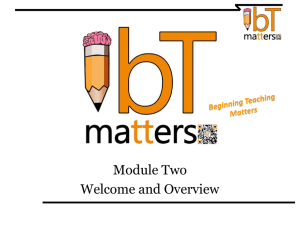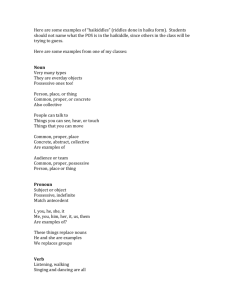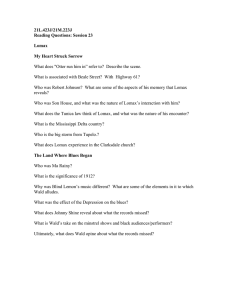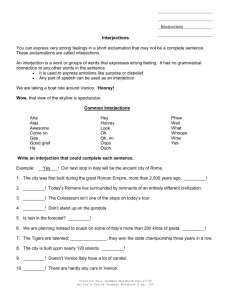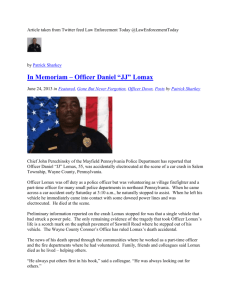Grammar-Parts of Speech
advertisement
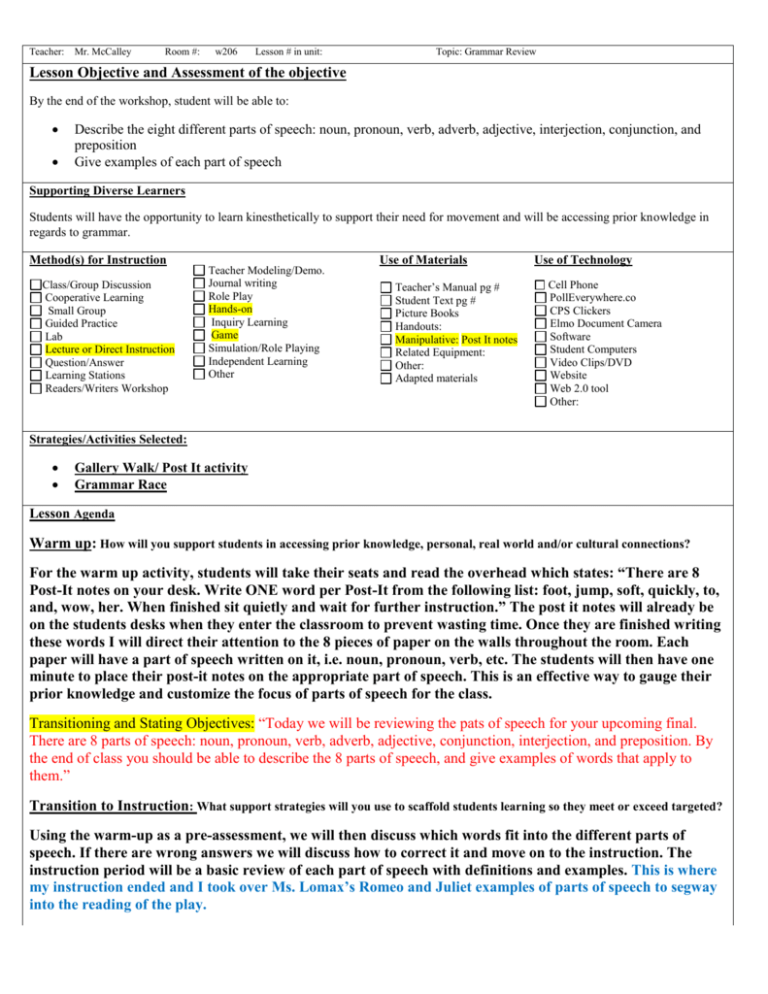
Teacher: Mr. McCalley Room #: w206 Lesson # in unit: Topic: Grammar Review Lesson Objective and Assessment of the objective By the end of the workshop, student will be able to: Describe the eight different parts of speech: noun, pronoun, verb, adverb, adjective, interjection, conjunction, and preposition Give examples of each part of speech Supporting Diverse Learners Students will have the opportunity to learn kinesthetically to support their need for movement and will be accessing prior knowledge in regards to grammar. Method(s) for Instruction Class/Group Discussion Cooperative Learning Small Group Guided Practice Lab Lecture or Direct Instruction Question/Answer Learning Stations Readers/Writers Workshop Teacher Modeling/Demo. Journal writing Role Play Hands-on Inquiry Learning Game Simulation/Role Playing Independent Learning Other Use of Materials Teacher’s Manual pg # Student Text pg # Picture Books Handouts: Manipulative: Post It notes Related Equipment: Other: Adapted materials Use of Technology Cell Phone PollEverywhere.co CPS Clickers Elmo Document Camera Software Student Computers Video Clips/DVD Website Web 2.0 tool Other: Strategies/Activities Selected: Gallery Walk/ Post It activity Grammar Race Lesson Agenda Warm up: How will you support students in accessing prior knowledge, personal, real world and/or cultural connections? For the warm up activity, students will take their seats and read the overhead which states: “There are 8 Post-It notes on your desk. Write ONE word per Post-It from the following list: foot, jump, soft, quickly, to, and, wow, her. When finished sit quietly and wait for further instruction.” The post it notes will already be on the students desks when they enter the classroom to prevent wasting time. Once they are finished writing these words I will direct their attention to the 8 pieces of paper on the walls throughout the room. Each paper will have a part of speech written on it, i.e. noun, pronoun, verb, etc. The students will then have one minute to place their post-it notes on the appropriate part of speech. This is an effective way to gauge their prior knowledge and customize the focus of parts of speech for the class. Transitioning and Stating Objectives: “Today we will be reviewing the pats of speech for your upcoming final. There are 8 parts of speech: noun, pronoun, verb, adverb, adjective, conjunction, interjection, and preposition. By the end of class you should be able to describe the 8 parts of speech, and give examples of words that apply to them.” Transition to Instruction: What support strategies will you use to scaffold students learning so they meet or exceed targeted? Using the warm-up as a pre-assessment, we will then discuss which words fit into the different parts of speech. If there are wrong answers we will discuss how to correct it and move on to the instruction. The instruction period will be a basic review of each part of speech with definitions and examples. This is where my instruction ended and I took over Ms. Lomax’s Romeo and Juliet examples of parts of speech to segway into the reading of the play. Transition Guided Practice: Students will get into their scrapbooking groups and be handed a sheet of computer paper. They will fold this into a piece of paper with 8 sections (hotdog style, 2 hamburger folds). Working as a group the students will write down the eight parts of speech from memory in each section. I will have words on the board that they will put into the correct section. Each part of speech will have 3 examples that must be correctly categorized in order for the group to win. The words are: finger, it, shoelace, walk, on, blue, softly, or, ouch, she, quickly, hair, talked, hard, very, wow, but, and, smooth, is, them, around, beneath, hey. Each group must complete the race even if they do not finish first. Transition to Independent Practice and Conferencing: After the game, the students will be assessed individually on their knowledge of the parts of speech. On a piece of paper they will copy the following sentence: “Wow, the fireman ran quickly toward the blazing fire to help them, and he saved their lives.” They will then label each of the eight parts of speech used in this sentence. Transition to Wrap up/Closing: How will you engage students in self-assessment and/or reflection on key concepts? At the bottom of the paper used in independent practice the students will answer the following question as an exit slip: Which part of speech are you struggling with the most? The students responses would help me in future lessons cover the troublesome parts of speech and can help Ms. Lomax in future lessons. Daily Assessment How do you know your students met your lesson objective(s) and to what extent? knowledge comprehension application analysis synthesis evaluation Formative: Class discussion CPS clickers Email teacher Entrance/Exit slip Teacher Observe Listened to conversations Quiz Thumbs up, neutral, or down Homework check Video quiz Voting Whiteboard Check Other Summative: Test Project Report Presentation Final Exam Other Additional Teacher Preparation: Copy: Locate: Notes on Parts of speech, sticky notes, Reflection: Due to assessment scores at the beginning of the semester, it was clear that the students needed review on the parts of speech. In this lesson I was only able to do the warm up activity I created and an activity relating the parts of speech to the play Romeo and Juliet. My co-op teacher was behind and had to catch the students up in the play because next week was their assessment. My warm-up activity went very well in my first class and everyone identified the proper parts of speech. This made is easy reviewing the definitions of the parts of speech and applying them to the Romeo and Juliet activity. The next class however did not know many of the terms and it took longer to explain the parts of speech to them. They also did not work independently in posting the sticky notes and I had to stop multiple off task conversations. If I were to do another activity like this one with my second class I would have them do the gallery walk by rows so that the process would be quicker and more efficient. Also, Prof. Mitchell made a good point on the cost of sticky notes throughout an entire day teaching 7 periods. It would get costly to use that many so it might be a better option to have the students uses scraps of paper.
